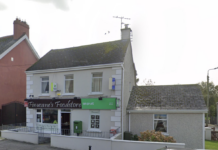WHEN we think of women being burned at the stake, historical figures like Joan of Arc or the women of the Salem Witch Trials often come to mind. However, buried in the annals of Irish history is a chilling account of the last recorded instance of a woman being legally burned to death in Ireland.
The tragic story of Alice Moran unfolded in Limerick on April 23, 1768. She faced the brutal consequences of being convicted of poisoning a woman named Joan Sullivan.
On January 30, 1768, Alice Moran was committed to the Limerick County Gaol. At the time, the gaol was situated on the aptly named Gaol Lane, off Mary Street, in the heart of Englishtown. This location, chosen for its strategic placement, was adjacent to the Tholsel, a local municipal and administrative building. The Tholsel served as a hub for collecting tolls and taxes, as well as administering trade and other important documents.
Constructed in 1750, the Limerick County Gaol encapsulated the grim reality of the legal system in 18th century Ireland. Gaol Lane, once a bustling thoroughfare, bore witness to the comings and goings of those entangled in the legal system.
The conditions within the Limerick County Gaol were undoubtedly harsh. As Alice Moran awaited trial, she would have experienced the unforgiving nature of incarceration at the time.
She waited in her cell until April when she appeared in the newly built courthouse on Bridge Street. This imposing courthouse with its large windows only opened three years earlier. The courthouse later became the Gerald Griffin Memorial School, then Gaelscoil Sáirséal, and now sits vacant after 250 years of activity.
Within the confines of the courthouse, the details of Alice Moran’s alleged crime began to surface. The prosecution painted a chilling picture of Moran’s visit to the Sullivan family home in Bruree, County Limerick. Armed with a small paper packet containing a mysterious powder, the story went, Moran approached Joan Sullivan claiming the substance was sugar.
Joan, a married woman, ingested the powder offered by Moran, believing it to be sugar as she was told. Little did she know that she was consuming a substance that would bring about her untimely demise.
The effects of the powder manifested quickly, plunging Sullivan into agonizing pain. Within two hours of ingesting the mysterious substance, Joan Sullivan succumbed to its lethal effects, leaving a community in shock and Alice Moran at the centre of a legal storm that shocked the country.
As the trial progressed at the Limerick Assize in the Bridge Street courthouse, the evidence against Alice Moran has been lost to time, as has any defence that she may have offered. We don’t know her age, her home, or her family situation. What we do know is the verdict that was delivered: Alice Moran was found guilty of murder.
On April 23, 1768, the condemned Alice Moran was escorted to Gallows Green, a notorious site for hangings just outside the protective walls of Limerick City, nestled in the Garryowen area. The very name hinted at the dark purpose of the place – a grim theatre where justice met its most macabre expression.
Moran, found guilty of the heinous crime of murder, was tied to a stake on that ominous day. Surrounding her was kindling, a stark symbol of the harsh justice meted out in the 18th century. As flames engulfed the scene, Alice Moran met her end in a horrifying display of punishment. The chilling details of Alice Moran’s execution highlight the harsh realities faced by those deemed guilty in a society where justice often took on a brutal and unforgiving form.
The newspapers of the time, while chronicling Alice Moran’s trial and subsequent execution, dedicated only a few lines to this extraordinary event. Unlike the visceral horror that such a fate might evoke in contemporary society, the accounts of Alice Moran’s burning were met with a surprising degree of stoicism.
The Dublin Gazette on April 28, 1768, wrote: ‘Limerick, April 25. Saturday last Alice Moran was executed at Gallows Green, pursuant to her sentence, for poisoning Joan Sullivan’.
The Oxford Journal of the same month told of the execution in simple terms: ‘At Limerick Assize, Alice Moran was convicted of the murder of Joan Sullivan, by poison, and sentenced to be burned on Saturday the 23rd instant.’
As the newspapers of the time moved on to other stories, the burning of Alice Moran became a historical footnote. Unbeknownst to contemporaries, this chilling episode marked the end of an era – the last known case of someone being legally burned to death in Ireland as a judicial punishment. The subsequent transformation of societal norms and legal practices would render such extreme forms of punishment relics of a brutal past.
The Treason by Women Act (Ireland) 1796 finally abolished burning of women as punishment, it was replaced with drawing, where the convicted was fastened to a hurdle, or wooden panel, and drawn by horse to the place of execution and hanging – which too was abolished in 1870.
On August 5, 1925, in Mountjoy Prison, another Limerick woman, Annie Walsh, became both the first woman executed by the new Irish Free State, at the hands of the famous English executor Pierpont, and the last woman to be executed in the Irish Free State and Republic of Ireland.











